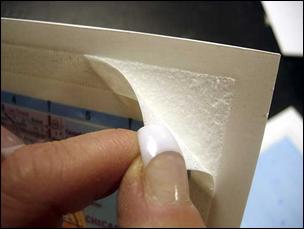 Photo 1
Photo 1
Tear strength is when the art or substrate surface paper is damaged or torn when attempting to pull them apart after adhesive has fully cured.
A canvas print is the reproduction of original oil or acrylic painting or photograph printed onto canvas, traditionally as an offset lithograph, but now as digital print. The technology behind wide-format printers allows artists, photographers, and publishers to print directly to digitally receptive canvas media which may then be stapled to traditional ¾" stretcher or strainer bars, stretched as a 1½" or 2" deeper gallery wrap, or glued to a rigid substrate for framing. In home décor canvas prints are often considered a cheaper alternative to framed prints since there are no mats or glazing. And since canvas prints are considered replaceable reproductions they are rarely framed using preservation treatment so the stretcher is not varnished or sealed.
There has been a great deal of discussion over the years surrounding the mounting of printed inkjet canvases to rigid substrates rather than stretching them around bars. When wide format digital images—as giclées—were first introduced it was thought they required stretching simply because the substrate media was canvas. Over the years that strict thinking has given way to more practical ways of handling this media. Paul MacFarland wrote in "Stretching Fine Art Canvas", PFM, October 2000, "Although many canvas prints are sold prestretched on strainer or stretcher bars, not all canvas prints may need them. Often a canvas print may be mounted to a panel of ½-inch foam center board or archival corrugated plastic and presented like a painting, using a liner and frame."
Mounting vs. Stretching
There are two issues that haunt digital canvas: flaking or rubbed ink, and sagging once stretched. Numerous misnomers have been posted online about stretching in warm weather, or cool weather, or not too tightly, all in an attempt to control sagging issues. None of these apply. By the end of 2009 discussions were popping up all over framing forums about the validity to mounting printed canvases to eliminate sagging and flaking issues entirely. Today the flaking issue has generally been resolved with the application of surface laminates or sealers allowing for the inks to become more pliable for stretching. But that does not resolve sagging.
There have been problems keeping lightweight printed canvases taught after stretching, with some canvases relaxing enough to flop and sag within an hour of completion. Tightening by restretching is an alternative but even then the sag can occur again—and again. Adding alternative support—such as the insertion of a 4-ply rag board between canvas and bars—has been considered a preventative measure in the event a canvas might be likely to sag. And at times poly fiberfill is suggested to help prevent loosened canvas from flopping.
Mounting is fast becoming the solution of choice for printed canvases. There are numerous printing companies who already offer their canvases mounted to foam board, cradled boxes, hardboard, or metal as an alternative to stretching. Another advantages to mounting, aside from sag prevention, is when displaying in public faculties and institutional settings where durability and impact resistance is important.
Preservation Issues
Noninvasive preservation framing may not be an option for canvas reproductions. When preservation is an issue for collectible giclées, mounting may not even be an option. It should be stressed again that adhesives are neutral pH, inert, stable, and will not damage, discolor or deteriorate any printed canvas, but the adhesive saturation that will forever remain in a canvas is what makes it non preservation. And mounting to a preservation-grade substrate such as alpha cellulose board or aluminum composite in an attempt to make an adhesive mount seem more museum-quality will never make it a reversible mount. Perhaps preservation should never be a consideration with any open edition canvas.
Reversible HA boards—Restore, Preserve and Preserve Ultra—though considered preservation are not aggressive enough for mounting any canvas. Over the years wet adhesives including acrylic gel, Lascaux 360, or heavy PVA Miracle Muck or Frank's Fabric Glue have been used for bonding canvas but moisture can be a problem with aqueous inks and needs to be avoided.
Tear Strength
Tear strength is when the art or substrate surface paper is damaged or the layers are torn when attempting to pull them apart after adhesive has fully cured (photo 1). In 2006 an extended test was conducted for mounting digitally printed canvases using PSA, HA, and rolled products to test tear strength with canvas images. P-S boards resulted in canvases holding moderately to Elmer's Quick Stick and Drytac high tack boards. All other P-S boards and P-S film adhesives including Gudy 870 and 831, PerfectMount film, and 3M PMA showed less than 50% bond, even after two months when put through rollers.
 Photo 1
Photo 1
Tear strength is when the art or substrate surface paper is damaged or torn when attempting to pull them apart after adhesive has fully cured.
At that time 150ºF was the low temperature for HA boards and most boards and tissue adhesives failed the T-peel test for tear strength leaving only a canvas imprint in the adhesive board. Of the film adhesives tested Fusion 4000 and GigléeMount were aggressive enough to illustrate tear strength but they bond at press temperatures of 190ºF or higher, which is not safe for all digital prints (photo 2). The end result was HA boards were only marginally successful for tear strength with Bainbridge HAF (Heat Activated Foam) being the superior choice.
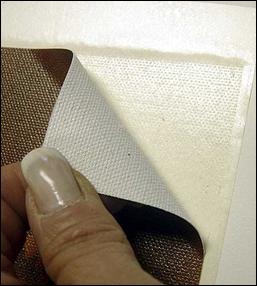 Photo 2
Photo 2
The canvas pulls from the board leaving an imprint of the canvas in the adhesive with no tear strength making this a marginal bond.
HAPSA Canvas Comparisons-053014
The challenge is to locate a dependable adhesive that will predictably bond printed canvases. Earlier this year a study was conducted to update the findings on the 2006 chart by specifically testing canvases being sold by industry publishers using the newest mounting products available. The test was designed to verify bonding aggressiveness at manufacturer suggested times and temperatures of HA boards, P-S boards and roll adhesives, and the accompanying 2014 chart features boards and adhesives tested for tear strength when bonding digitally printed canvases of many types (chart 1).
Kool Tack InstaMount P-S board was tested with Drytac JetMounter roll laminator and manually applied then weighted overnight. InstaMount has an overall high tack with little room for repositioning which aggressively bonds porous papers and digital prints, fabrics only lightly, but failed bonding digital canvas.
E2 is Kool Tack's high density, fabric mount, clay coat, board. Mount temperature is 170ºF for 1 minute mechanical press and 3 minutes vacuum dwell time for best results. It is great for porous paper, rice paper, smooth prints and RA-4 photos but failed for polyester encapsulates, dye sublimation, and digital canvas. The E2 boards are warped when removed from the case prior to bonding (photo 3) which is usually the result of stresses from adhesive application.
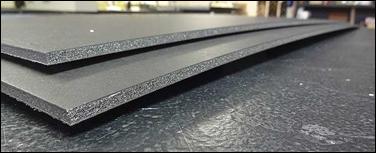 Photo 3
Photo 3
KoolTack HA boards (Original, Black, AF, Preserve Ultra and E2) are warped prior to bonding. These are shown adhesive side down to illustrate the curve.
SuperStickHeat Assist Giclee Canvas Mounting Adhesive by D&K Group has been designed to mount printed canvas to any non-porous substrate using a heated roller press, mechanical or vacuum system. It is a thermoplastic, removable adhesive film which is compatible with Ryno I, Gatorboard, foam board, Sintra, Coroplast, MDF board, Masonite, and PMMA acrylic sheet.
MountCor Canvas
This year Gilman Brothers launched MountCor Canvas (MMC) to their MountCor HA board line featuring the same 130°F low temperature, permanent adhesive, and each with a disposable gridded release liner. The adhesive is not only thicker than MountCor's but the formulation has been altered to better accommodate the textural needs of bonding canvas. An aggressive bond is required for permanence of all long term mounting of paper, digital, fabric, polyester encapsulation and canvas. Results confirm maximum tear strength for everything tested including canvas (photo 4).
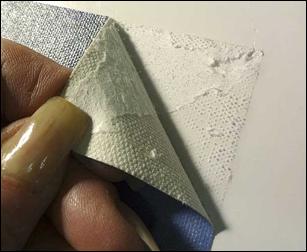 Photo 4
Photo 4
This MountCor Canvas bond clearly illustrates tear strength which is required for canvas.
The reusable gridded liner is useful for image alignment and as disposable release paper as long as the image is a single mount in a mechanical press. MountCor Canvas's permanent adhesive makes it the only low temp HA board available for mounting oversized wide-format canvases in bites (photo 5). When using the gridded liner it's grab to the outer edges of the HA board tends to trap air during bites so the liner must be removed during that technique (photo 6). Since a release board is necessary to dissipate pressure at the platen edges during bites to prevent dents no other release paper is needed.
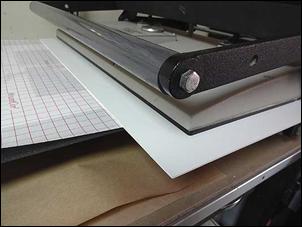 Photo 5
Photo 5
The gridded liner should be removed when multiple biting in a mechanical press and always use an over sized release board as shown.
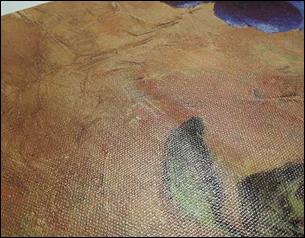 Photo 6
Photo 6
When the gridded liner is left on a multiple bite mount it traps air and encourages unmounted bubbles when at the overlap point.
In order to fully cover the HA board in a vacuum press a slightly oversized single-sided release paper is advised rather than using the same size gridded liner. A release board is never required for any vacuum mount and MCC will bond full sized canvases at 130°F in the routine 4 minutes in a 40x60" press (photo 7). If a release board is desired always increase the dwell time to 5 to 8 minutes—depending on draw and press size—while always maintaining 130°F temperature.
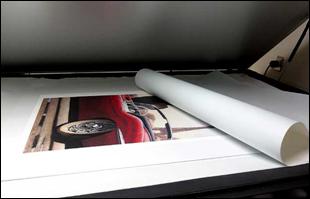 Photo 7
Photo 7
Single-sided release paper is preferred over the MountCor gridded release liner when bonding with MountCor Canvas. If a release board is desired always increase the time not the temperature. Maintain 130ºF.
Canvas for Printing
If choosing to dry mount an open edition printed canvas the type of inkjet printer must be known as aqueous, solvent, UV, or latex. Aqueous and latex inks are heat safe but solvent inks can surface damage over 150ºF. It was also established that canvases mount and grab differently depending on fabric content and weight. The color of the canvas helps identify the content with white or warm white as poly-cotton blends and crème as cotton (photo 8). There was also one bright white 100% polyester (not shown).
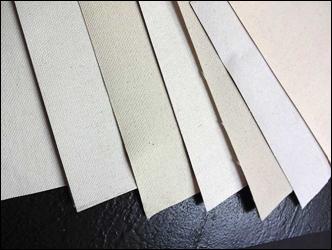 Photo 8
Photo 8
The color of the canvas helps identify the type of canvas. The white canvases are poly-cotton blend and the warm crème/off-white are cotton. One unshown canvas was a pure polyester, also very white.
Tested canvases were supplied by Intelicoat, HP, Epson, Wild Apple Graphics, Grand Image, and Editions Limited. A wide assortment of current release and older published canvases tested included Crane Museo Maestro; Breathing Color Solvent Canvas; Magiclée Torino 21G, Torino 20M and 17M; Fredrix Litho Canvas; HP Collector Satin and Pro Matte Canvas; Fredrix Inkjet Canvas; and Epson Matte Canvas. Not pictured are Breathing Color Silverada SUL (solvent, UV, latex); and GFCVM lightweight for latex inkjet which were tested later (photo 9). Results showed that some canvases grab better than others but all held very well to MountCor Canvas.
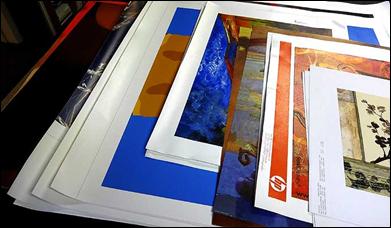 Photo 9
Photo 9
Tested canvases included (L-R) Crane Museo Maestro; Breathing Color Solvent Canvas; Magiclée Torino 21G, Torino 20M and 17M; Fredrix Litho Canvas; HP Collector Satin and Pro Matte Canvas; Fredrix Inkjet Canvas; and Epson Matte Canvas. Not pictured are Breathing Color Silverada SUL (solvent, UV, latex); and GFCVM lightweight for latex inkjet.
Final
A printed canvas must look like a painted canvas, but it will look that way whether stretched or rigidly mounted. There may always be two schools of thought over stretching vs. mounting, but thankfully manufacturers have risen to the occasion and given today's framers options when mounting canvases. Printed canvases are not your grandmother's oil painting, and mounting may indeed be the best option for displaying printed canvases, after all, they are only digital copies.
END
Copyright © 2014 Chris A Paschke
Additional Reading
most available online at http://www.designsinkart.com/articles-subject.htm
"Adhesive Coated Substrate Boards", Mastering Mounting, PFM, May 2014.
"Pros and Cons of Mounting Digital Canvases", PPFA/FMO, September 2009.
"Adhesives for Digital Canvases", Mastering Mounting, PFM, June 2006.
"Digital Canvases And The Adhesives That Love Them", PFM, October 2006.
"Handling & Framing Giclée Prints", Paul MacFarland, Giclée Today, August 2001.
"Stretching Fine Art Canvas", Paul MacFarland, PFM, October 2000.
Resources—Items
http://www.dkgroup.com—SuperStick Giclée Mounting Adhesive
http://www.gilmanbrothers.com—MountCor, MountCor Canvas
http://www.kooltack.com—E2, InstaMount board
http://www.artsupply.com—Alcan, Elmer's, Gilman, United Industries
http://www.foamboardsource.com—SA Gator, SA Sintra, SA Ryno, HA boards
http://www.foamcoreheaven.com—SpeedMount, HAF
For more articles on mounting basics look under the mounting section in Articles by Subject.
Additional information on all types of mounting is found in:
The Mounting and Laminating Handbook, Second Edition, 2002,
The Mounting And Laminating Handbook, Third Edition, 2008 and
Creative Mounting, Wrapping, And Laminating, 2000 will teach you everything you need to know about getting the most from your dry mount equipment and materials as an innovative frame designer.
All books are available from Designs Ink Publishing through this website.
Chris A Paschke, CPF GCF
Designs Ink
Designs Ink Publishing
785 Tucker Road, Suite G-183
Tehachapi, CA 93561
P 661-821-2188
chris@designsinkart.com